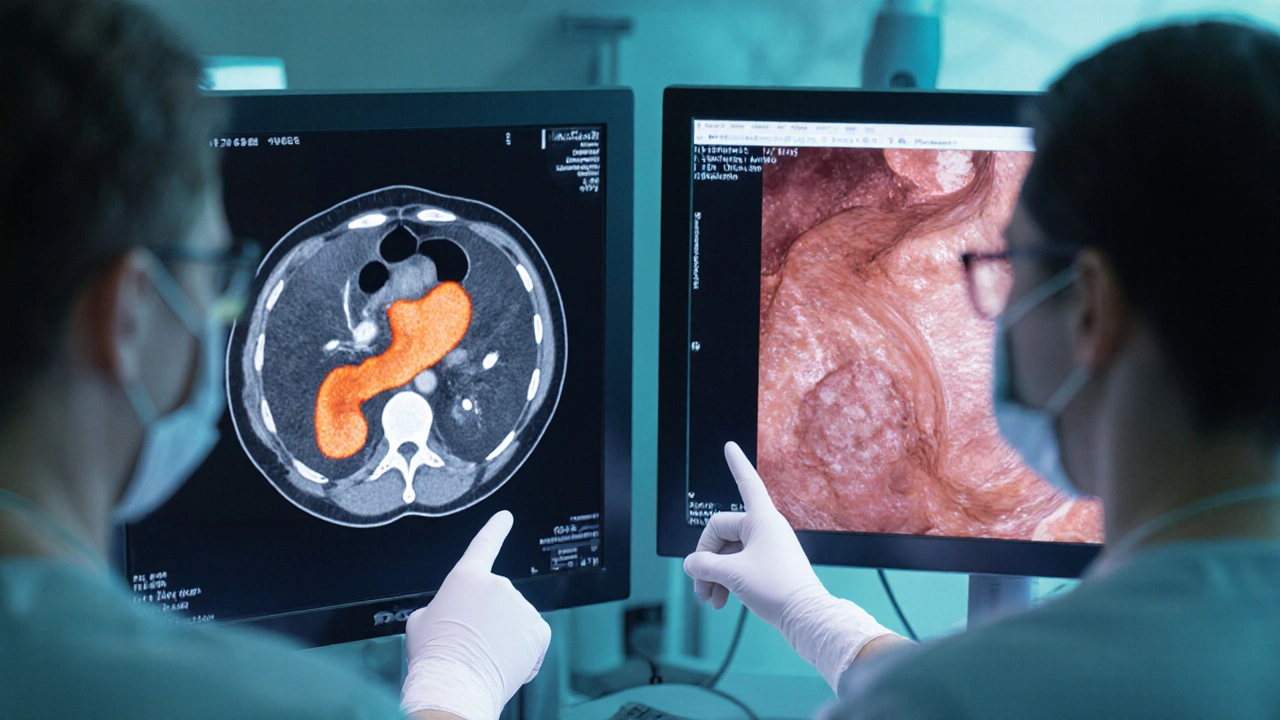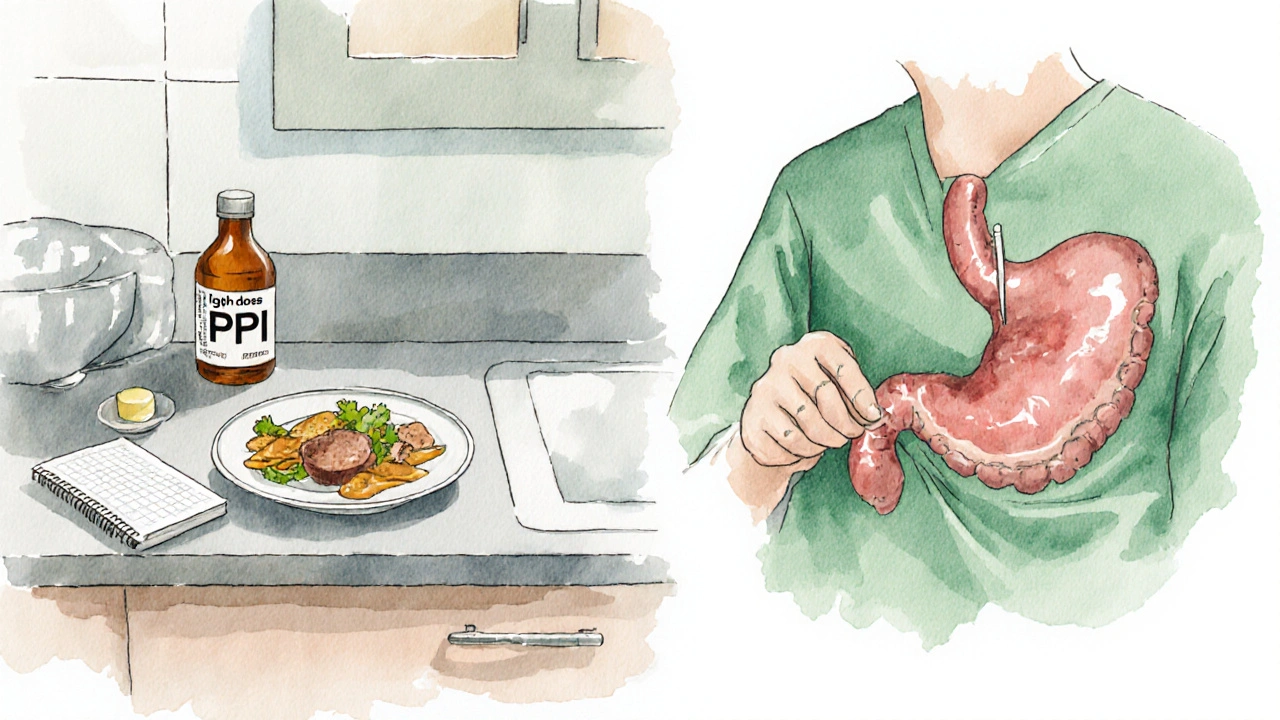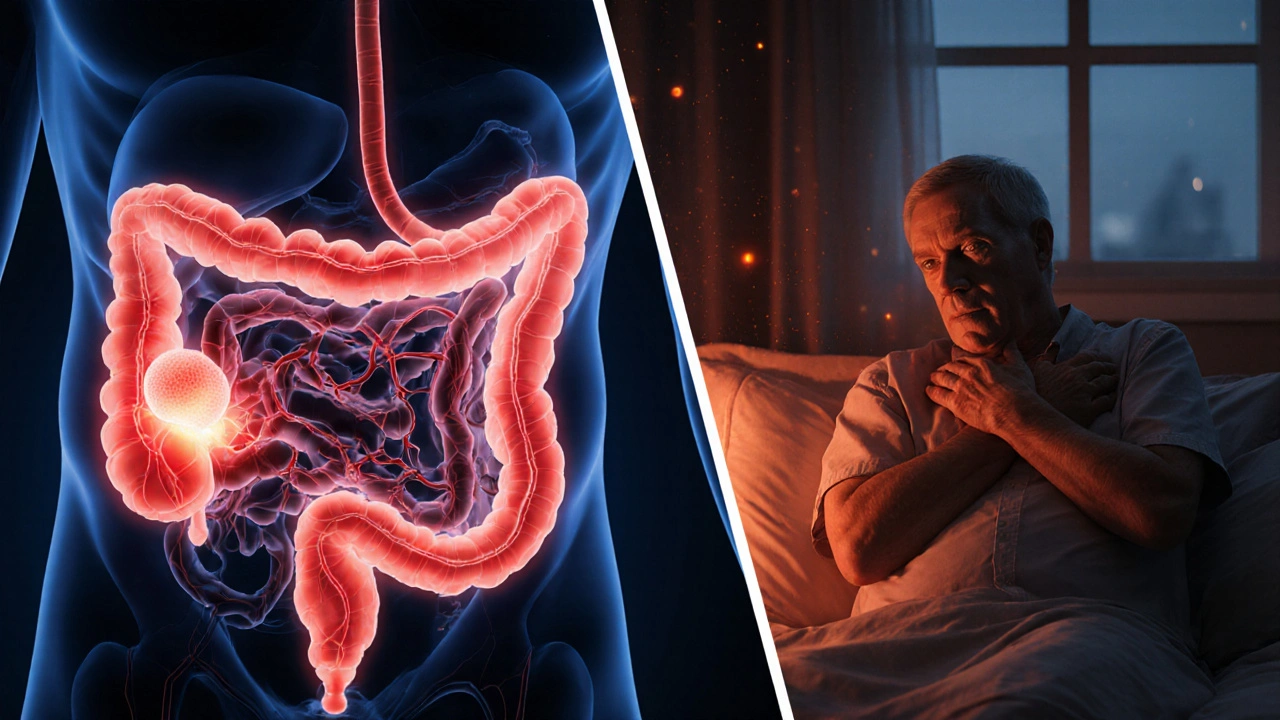Zollinger-Ellison Syndrome vs GERD Comparison Tool
Zollinger-Ellison Syndrome (ZES)
Key Facts:
- Rare neuroendocrine tumor disorder
- Tumors secrete excess gastrin
- Causes excessive stomach acid production
- Often associated with MEN1 syndrome
- Requires high-dose PPI treatment
Diagnosis:
- High fasting gastrin levels (>1000 pg/mL)
- Imaging studies (CT, MRI, Octreoscan)
- Biopsy of suspected tumors
Gastroesophageal Reflux Disease (GERD)
Key Facts:
- Common chronic condition
- Caused by LES dysfunction
- Reflux of stomach acid into esophagus
- Linked to lifestyle factors
- Responds well to standard PPI doses
Diagnosis:
- Endoscopy to assess esophagitis
- pH monitoring
- Symptom review and response to treatment
Key Differences and Similarities
| Feature | Zollinger-Ellison Syndrome | GERD |
|---|---|---|
| Primary Cause | Gastrin-secreting tumor | LES dysfunction + lifestyle factors |
| Acid Level | Very high (often >5× normal) | Normal-high, variable |
| Typical Ulcer Locations | Duodenum, jejunum, sometimes gastric | Stomach or esophagus (only if reflux severe) |
| Response to PPIs | High doses needed (40-80 mg daily) | Standard dose usually sufficient |
| Associated Syndromes | MEN1, neuroendocrine tumor syndromes | Obesity, hiatal hernia |
| Diagnostic Test | Fasting serum gastrin + imaging | Upper endoscopy, pH monitoring |
Symptom Overlap
Patients with ZES often present with classic GERD-like symptoms due to excessive acid production:
- Burning chest pain (heartburn)
- Regurgitation of sour fluid
- Difficulty swallowing (dysphagia) from esophageal irritation
However, ZES-related reflux can cause deeper esophageal ulcers than typical GERD lesions.
When stomach acid goes rogue, two conditions often get blamed: Zollinger-Ellison syndrome is a rare disease where tumors called gastrinomas pump out excess gastrin, driving the stomach to produce huge amounts of acid. GERD, or gastroesophageal reflux disease, is far more common and happens when acid repeatedly backs up into the esophagus, causing heartburn and damage.
What Exactly Is Zollinger‑Ellison Syndrome?
Zollinger‑Ellison syndrome is a neuroendocrine tumor disorder that originates mostly in the duodenum or pancreas. The tumors secrete gastrin, a hormone that tells the stomach lining to make acid. Normal gastrin levels hover around 50 pg/mL; in ZES they can sky‑rocket above 1,000 pg/mL, leading to chronic gastric acid hypersecretion.
- Incidence: roughly 1 in 1,000,000 people per year.
- Age of onset: typically 30‑60 years.
- Associated condition: about 25% of cases occur in patients with multiple endocrine neoplasia type 1 (MEN1).
Understanding GERD in Plain Terms
Gastroesophageal reflux disease (GERD) is the chronic irritation of the esophagus caused by acid that slips up from the stomach. Most people experience occasional heartburn, but GERD is diagnosed when those episodes happen at least twice a week or cause complications like esophagitis.
- Prevalence: affects up to 20% of Western adults.
- Key risk factors: obesity, smoking, hiatal hernia, certain foods.
- Typical treatment: lifestyle changes plus proton pump inhibitors (PPIs).
Why Do the Two Conditions Overlap?
Both ZES and GERD involve too much stomach acid, but the reasons differ. In ZES the stomach is told to crank out acid nonstop because of the gastrinoma. In GERD the lower esophageal sphincter (LES) relaxes too often, allowing whatever acid is present to reflux. When ZES produces massive acid loads, even a normally functioning LES can become overwhelmed, leading to GERD‑like symptoms.
Patients with ZES often report classic GERD complaints:
- Burning chest pain (heartburn).
- Regurgitation of sour fluid.
- Difficulty swallowing (dysphagia) from esophageal irritation.
Because the acid is so aggressive, ZES‑related reflux can cause ulcerations in the esophagus that are deeper than typical GERD lesions.

Spotting the Differences: Symptoms and Signs
| Feature | Zollinger‑Ellison Syndrome | GERD |
|---|---|---|
| Primary cause | Gastrin‑secreting tumor | LES dysfunction + lifestyle factors |
| Acid level | Very high (often >5× normal) | Normal‑high, variable |
| Typical ulcer locations | Duodenum, jejunum, sometimes gastric | Stomach or esophagus (only if reflux severe) |
| Response to PPIs | High doses needed, often 40‑80mg daily | Standard dose usually sufficient |
| Associated syndromes | MEN1, neuroendocrine tumor syndromes | Obesity, hiatal hernia |
| Diagnostic test of choice | Fasting serum gastrin level + imaging (CT, MRI, somatostatin scan) | Upper endoscopy, pH monitoring |
How Doctors Diagnose Each Condition
For GERD, clinicians start with a symptom review, then may order an upper endoscopy to look for esophagitis or Barrett’s esophagus. A 24‑hour pH probe can objectively confirm acid exposure.
ZES requires a different work‑up. The first clue is an unusually high fasting gastrin level-often above 1,000 pg/mL. If the patient is on PPIs, the test must be done after a washout period of at least one week, otherwise levels can be falsely elevated. Once gastrin is confirmed, imaging studies locate the gastrinoma: contrast‑enhanced CT, MRI, or a specialized somatostatin receptor scintigraphy (Octreoscan) is highly sensitive.
Treatment Paths: Managing Acid Overload
Both conditions rely heavily on suppressing acid, but the intensity differs.
- Proton pump inhibitors are first‑line for GERD. Typical doses: omeprazole 20‑40mg daily.
- For ZES, PPIs are still the backbone, but patients often need high‑dose regimens-omeprazole 60‑120mg per day, sometimes split into twice‑daily dosing.
- If PPIs fail to control symptoms, somatostatin analogs (e.g., octreotide, lanreotide) can shrink gastrinomas and lower gastrin secretion.
- Surgical removal of the tumor offers a potential cure, especially when the disease is localized.
- Lifestyle tweaks-weight loss, avoiding trigger foods, elevation of the head of the bed-help GERD but have limited impact on ZES‑driven reflux.
Because ZES can cause multiple ulcers throughout the small intestine, patients may also need acid‑binding agents like sucralfate for ulcer protection.

Living With Both Conditions: Practical Tips
- Track symptoms meticulously. Note timing, severity, and any food or medication triggers. This data helps your doctor fine‑tune PPI dosing.
- Never stop PPIs abruptly. A taper plan prevents rebound acid hypersecretion, which can be especially severe in ZES.
- Schedule regular endoscopic surveillance if you have ZES. Ulcers can bleed or perforate, and long‑term acid suppression carries a small risk of gastric polyps.
- Stay on top of MEN1 screening if you have ZES-annual calcium, parathyroid hormone, and pituitary hormone tests can catch related tumors early.
- Maintain a lean waistline. Even modest weight loss can lower intra‑abdominal pressure, reducing GERD episodes.
When to Seek Immediate Care
Both conditions can lead to emergencies.
- Sudden, severe abdominal pain with vomiting may signal a bleeding ulcer-a medical emergency.
- Persistent vomiting of black or bloody material requires urgent attention.
- New‑onset difficulty swallowing, weight loss, or an alarming increase in heartburn frequency should prompt a fast endoscopic evaluation.
Frequently Asked Questions
Can GERD cause Zollinger‑Ellison syndrome?
No. GERD is a functional disorder of the LES, while ZES is caused by a gastrin‑secreting tumor. However, the massive acid output in ZES can produce GERD‑like symptoms.
Do I need a different diet for ZES versus GERD?
Both benefit from avoiding high‑acid foods, caffeine, and alcohol. ZES patients may also need to limit large meals that stimulate gastrin release, but diet alone won’t control the disease without medication.
Is surgery curative for Zollinger‑Ellison syndrome?
If the gastrinoma is found early and can be completely removed, surgery can cure the condition. Unfortunately, many tumors are discovered after they’ve spread, making surgery part of a broader management plan.
Why do ZES patients need higher doses of PPIs?
The sheer volume of acid produced overwhelms standard PPI doses. Higher doses keep the proton pumps fully inhibited, preventing breakthrough ulcer formation.
Can long‑term PPI use cause problems?
Long‑term PPI therapy has been linked to mild nutrient malabsorption (e.g., magnesium, B12) and a slightly increased risk of stomach polyps. Regular monitoring and occasional drug holidays, under doctor guidance, can mitigate these risks.

siddharth singh
October 7, 2025 AT 15:12Zollinger‑Ellison syndrome (ZES) is fundamentally a gastrin‑producing neuroendocrine tumor that drives stomach acid production far beyond physiological levels.
Because the acid output can be five to ten times normal, even a properly functioning lower esophageal sphincter can be overwhelmed, leading to classic GERD‑like heartburn.
In contrast, typical GERD stems from mechanical or functional failure of the sphincter, often aggravated by obesity, diet, or hiatal hernia, without the hormonal excess.
Diagnostically, ZES requires a fasting gastrin measurement exceeding 1,000 pg/mL and imaging such as contrast‑enhanced CT, MRI, or somatostatin receptor scintigraphy to locate gastrinomas.
GERD diagnosis, on the other hand, usually begins with symptom assessment, followed by endoscopy or 24‑hour pH monitoring if complications are suspected.
Pharmacologically, both conditions rely on proton‑pump inhibitors (PPIs), but ZES patients frequently need high‑dose regimens-often 60–120 mg of omeprazole per day split into multiple doses.
Standard GERD therapy generally stays within the 20–40 mg daily range, which suffices for most patients because the acid burden is lower.
When PPIs fail to control ZES‑related acid hypersecretion, adjunctive treatments such as somatostatin analogs (octreotide or lanreotide) can suppress gastrin release and shrink tumors.
Surgical resection of gastrinomas offers a potential cure, especially when the disease is localized, whereas surgery plays a limited role in uncomplicated GERD.
Lifestyle modifications-weight loss, head‑of‑bed elevation, and avoidance of trigger foods-remain cornerstone measures for GERD but have only modest impact on ZES because the hormone‑driven acid production persists.
Patients with ZES should also be screened regularly for associated MEN1 manifestations, including hyperparathyroidism and pituitary adenomas, because these co‑morbidities influence overall management.
Endoscopic surveillance is advised for ZES patients to monitor ulcer healing and detect possible complications such as bleeding or perforation.
For GERD, periodic endoscopy is recommended mainly when alarm symptoms appear or when long‑term PPI use raises concern for Barrett’s esophagus.
Both conditions can present with heartburn, regurgitation, and dysphagia, but the presence of multiple refractory duodenal ulcers or markedly elevated gastrin levels tips the balance toward ZES.
Ultimately, a nuanced understanding of the pathophysiology allows clinicians to tailor acid‑suppressive therapy, decide on surgical intervention, and implement appropriate surveillance strategies for each disorder.
Angela Green
October 22, 2025 AT 16:19Great summary! The comparison table makes the key differences crystal clear.
I especially appreciate the note about high‑dose PPI requirements for ZES versus standard dosing for GERD.
The article also correctly highlights the importance of ruling out MEN1 when a gastrinoma is discovered.
Patients will benefit from the practical tips on lifestyle changes and regular endoscopic monitoring.
Overall, a very informative and well‑structured post-thanks for sharing!
April Malley
November 6, 2025 AT 17:26Wow, this post really breaks down a super complicated topic, and does it in a way that even my grandma could get it, lol!
The side‑by‑side table is *awesome*, it shows the acid levels, ulcer locations, and treatment doses all at a glance, so no more googling endless pages.
I love the reminder that weight loss and head‑of‑bed elevation help GERD, but won’t magically fix ZES, which is a good reality check.
Definitely bookmarking this for my next chat with the doctor, thanks a ton!!!
scott bradshaw
November 21, 2025 AT 18:32Oh sure, just crank up the PPI and everything's fine, right?
Because ignoring a gastrin‑secreting tumor is exactly what modern medicine does.
Guess we’ll all just live with ulcers forever.